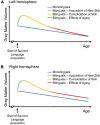The influence of bilingualism on gray matter volume in the course of aging: a longitudinal study
- PMID: 37547741
- PMCID: PMC10400456
- DOI: 10.3389/fnagi.2023.1193283
The influence of bilingualism on gray matter volume in the course of aging: a longitudinal study
Abstract
Background: Bilingualism is associated with higher gray matter volume (GMV) as a form of brain reserve in brain regions such as the inferior frontal gyrus (IFG) and the inferior parietal lobule (IPL). A recent cross-sectional study reported the age-related GMV decline in the left IFG and IPL to be steeper for bilinguals than for monolinguals. The present study aimed at supporting this finding for the first time with longitudinal data.
Methods: In the current study, 200 participants aged 19 to 79 years (87 monolinguals, 113 sequential bilinguals, mostly native German speakers with variable second language background) were included. Trajectories of GMV decline in the bilateral IFG and IPL were analyzed in mono- and bilinguals over two time points (mean time interval: 3.6 years). For four regions of interest (left/right IFG and left/right IPL), mixed Analyses of Covariance were conducted to assess (i) GMV changes over time, (ii) GMV differences for language groups (monolinguals/bilinguals), and (iii) the interaction between time point and language group. Corresponding analyses were conducted for the two factors of GMV, surface area (SA) and cortical thickness (CT).
Results: There was higher GMV in bilinguals compared to monolinguals in the IPL, but not IFG. While the left and right IFG and the right IPL displayed a similar GMV change in mono- and bilinguals, GMV decline within the left IPL was significantly steeper in bilinguals. There was greater SA in bilinguals in the bilateral IPL and a steeper CT decline in bilinguals within in the left IPL.
Conclusion: The cross-sectional observations of a steeper GMV decline in bilinguals could be confirmed for the left IPL. Additionally, the higher GMV in bilinguals in the bilateral IPL may indicate that bilingualism contributes to brain reserve especially in posterior brain regions. SA appeared to contribute to bilinguals' higher GMV in the bilateral IPL, while CT seemed to account for the steeper structural decline in bilinguals in the left IPL. The present findings demonstrate the importance of time as an additional factor when assessing the neuroprotective effects of bilingualism on structural features of the human brain.
Keywords: aging; bilingualism; brain reserve; gray matter volume; inferior frontal gyrus; inferior parietal lobule.
Copyright © 2023 Peitz, Stumme, Jockwitz, Bittner, Caspers and Heim.
Conflict of interest statement
The authors declare that the research was conducted in the absence of any commercial or financial relationships that could be construed as a potential conflict of interest.
Figures





References
-
- Abutalebi J., Green D. W. (2016). Neuroimaging of language control in bilinguals: Neural adaptation and reserve. Bilingualism 19 689–698. 10.1017/S1366728916000225 - DOI
-
- Abutalebi J., Canini M., Della Rosa P. A., Green D. W., Weekes B. S. (2015). The neuroprotective effects of bilingualism upon the inferior parietal lobule: A structural neuroimaging study in aging Chinese bilinguals. J. Neurolinguist. 33 3–13. 10.1016/j.jneuroling.2014.09.008 - DOI
LinkOut - more resources
Full Text Sources

